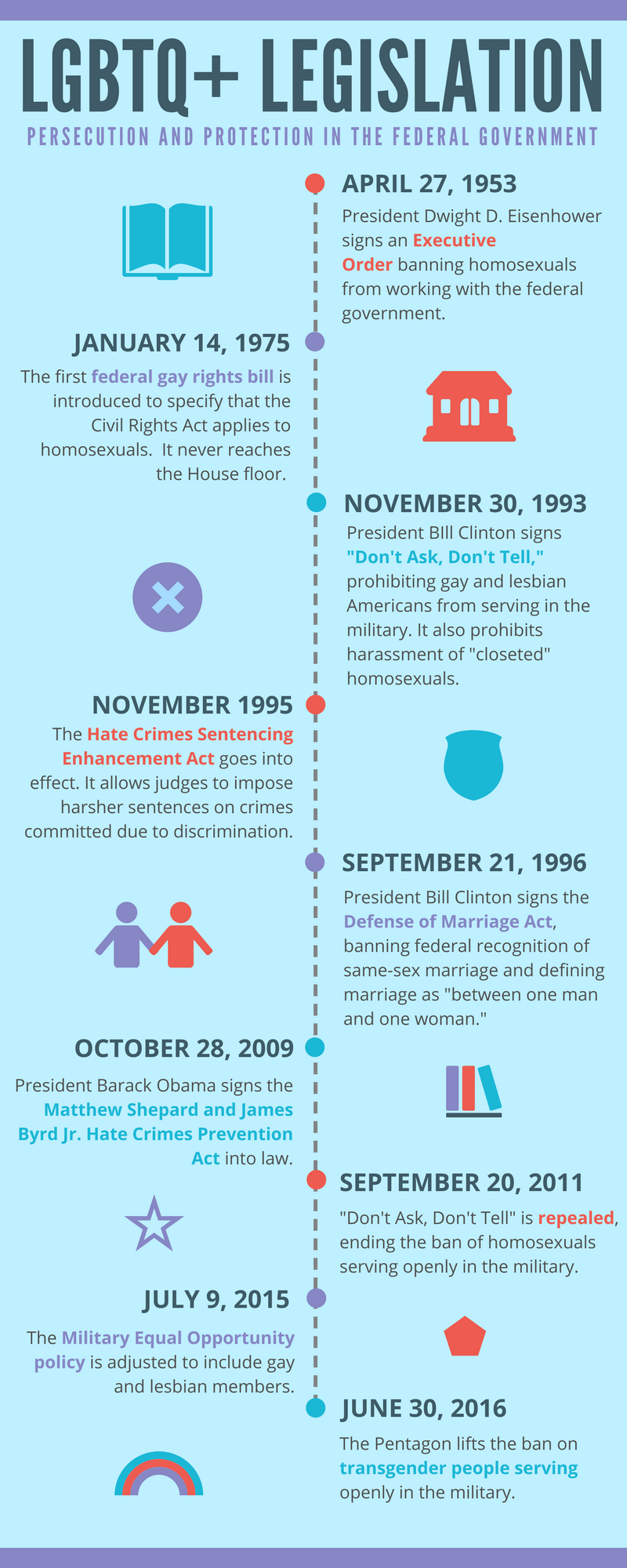|
The United States government has had a tormentalous history regarding LGBTQ+ people over the past sixty-five years. From persecution to protection, legislation affecting LGBTQ+ people has changed drastically, from banning homosexuals in the government to protecting them.
On April 27, 1953, President Dwight D. Eisenhower signed Executive Order 10450. Stating “any criminal, infamous, dishonest, immoral, or notoriously disgraceful conduct, habitual use of intoxicants to excess, drug addiction, or sexual perversion,” it was broadly interpreted and used to effectively ban gays and lesbians from the federal workforce. It wasn’t until the 1990’s when this order was lifted fully. The U.S. Civil Service Commission re-allowed gays and lesbians in federal civil service in 1975, while in 1977, the state department lifted a ban on gays in the Foreign Service. President Bill Clinton’s “Don’t Ask, Don’t Tell” policy allowed lesbians and gays a place once more in the military in 1995. Bella Abzug introduced a bill to Add Sexual Orientation to Federal Civil Rights Law on January 14, 1975. It was the first federal lesbian and gay rights bill in the federal government, and intended to apply the Civil Rights Act of 1965 to protect sexual orientation. It never reached the house floor. Don’t Ask Don’t Tell, signed into law November 30, 1993 by Bill Clinton, prohibited the military from discriminating against closeted homosexual or bisexual service members. However, openly homosexual or bisexual people were banned completely from military service reasoning that “would create an unacceptable risk to the high standards of morale, good order and discipline, and unit cohesion that are the essence of military capability.” Members who spoke about homosexual relations could be rapidly discharged. In November 1995, the Hate Crimes Sentencing Enhancement Act is added and enacted as an amendment to the Violent Crime and Law Enforcement Act of 1994. Passed by the 103rd Congress, it allowed harsher penalties for hate crimes, especially those based on disability, gender, and sexual orientation and which occurred on federal property. The Defense of Marriage Act, signed November 21, 1996, defined marriage as between a man and a woman in regards to federal law. It allowed states to refuse to recognize same-sex marriages officiated in other states or countries, and effectively banned same-sex partnerships from receiving federal marriage benefits awarded to heterosexual couples. Section 3 specified non-recognition of same-sex marriages in federal government, immigration, bankruptcy, joint tax returns, social security survivors’ benefits, certain federal protections, financial aid eligibility, and ethics laws. President Obama’s administration brought forth the Matthew Shepard and James Byrd, Jr., Hate Crimes Prevention Act on October 28, 2009, which expanded a 1969 federal hate crime law to include gender, sexual orientation, gender identity, or disability based motivation. It removed requirements such as victims having involvement in federal activities such as voting, and allowed federal authorities to pursue hate crimes investigations that localities had abandoned. Furthermore, it provided funding to help state and local agencies investigate hate crimes, and required the FBI to track gender and gender identity based hate crime statistics. In December 2010, the Don’t Ask, Don’t Tell Repeal Act which banned openly gay, bisexual, and lesbian members from service. It went into effect on September 20, 2011 after an extended period of preparation, as Pentagon and military leaders were reluctant to lift the ban while in the midst of war. The Pentagon also trained over 1.9 million of the 2.2 million military members on proper conduct around their fellow gay, bisexual, and lesbian servicepeople. Additionally, the military began to look into giving same-sex couples limited health, housing, and legal benefits. The Military Equal Opportunity Policy was updated to include gay and lesbian servicemembers on July 9, 2015, as revealed by Defense Secretary Ash Carter. It “ensures that the department, like the rest of the federal government, treats sexual-orientation-based discrimination the same way it treats discrimination based on race, religion, color, sex, age and national origin.” On June 30, 2016, Defense Secretary Ash Carter announced that the Pentagon had lifted the ban on transgender service members. Estimations range from affecting about 0.1% of the 2 million member military, or about 2000 service members to over 12000 members. Full implementation is expected by July 1, 2017. Sources: x x x x x x x x x Comments are closed.
|
About LGBTQ+ of FIRST
LGBTQ+ of FIRST is a student run organization that advocates awareness and acceptance of LGBTQ+ students, mentors, and volunteers of FIRST Robotics. LGBTQ+ of FIRST reaches out to over 1000 members across the FIRST regions and fronts multiple outreach endeavors. Archives
June 2024
Categories
All
|



 RSS Feed
RSS Feed
